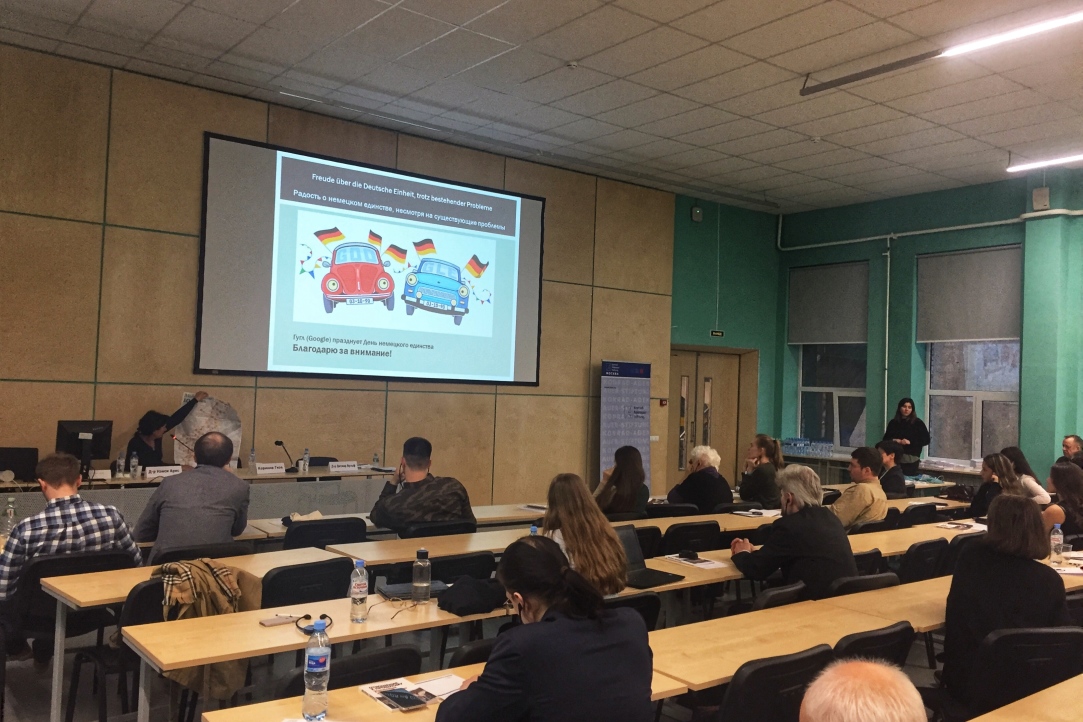Understanding the two dictatorships: report from the joint seminar of the Konrad Adenauer Foundation and CHR

On April 9, the Konrad Adenauer Foundation and Center for Historical Research held a seminar on the history of understanding two dictatorships: the Nazi and the dictatorship of the SED. The seminar was opened by Corinna Giza, an employee of the German Consulate General in St. Petersburg, who stressed that the politics of memory conducted by the state always has a great influence on culture. Post-war Germany pays great attention to historical enlightenment concerning the politics of memory. Nowadays the crimes of the regimes and the memory about the victims play a crucial role in the Federal Republic of Germany: many institutions and organizations are engaged in preserving testimonies and memories for future generations. The foundation for understanding the dictatorship of the SED constitutes an especially important part of these studies. Long-term DAAD associate professor Dietmar Wulff, who participated in the seminar, spoke about the importance of working with the historical past, which never passes, cannot be overcome, and cannot be fully comprehended. Working with the past is an ongoing struggle, interaction and the formation of a definite attitude towards history.
The paper of the seminar was presented by Dr. Nancy Ares, Deputy Commissioner for the Comprehension of the SED dictatorship in Saxony. Dr. Ares began her speech by asking why we should remember our past. The answer is that memory and memories relate to the present; it is impossible to understand 'today' without paying attention to 'yesterday'. German history associated with the comprehension of the two dictatorships, has more than 70 years history but the journey that Germany has made was very hard. From 1945 to 1989 there were two different Germanies (FRG and GDR), two completely different memory policies. Since 1989 the united Germany has tried to connect the memory of the two dictatorships.
Immediately after the war the population was shocked to see the scale of the destruction, the crimes and the horrors of the concentration camps. However, this shock was not followed by a critical understanding of military events. The Nuremberg process set the agenda for those years. For an ordinary German, the events of 1945 meant defeat, not liberation. The blame for the crimes of the regime was shifted onto the shoulders of the system (on the Fuhrer and his entourage), while the people saw themselves in the role of the victim. Under Konrad Adenauer, the FRG admitted guilt. In 1951 the government declared the need to pay compensation to the victims; a step in the negotiation process with Israel was taken. Nevertheless, most of the former administration and bureaucratic apparatus held their seats in the government of the state, replacing the SS patches with formal business suits. Even in the Bundestag, a quarter of the deputies could consist of former members of the Nazi Party.
Requirements for change were first heard in the 1960s, thanks to students who were insisting on Nazi criminals prosecution. Thanks to civil initiatives memorials were created (for example, the Dachau Memorial Museum (KZ Gedenkstdtte Dachau) in 1965). An invaluable role was played by such figures as the judge and prosecutor Fritz Bauer, who organized the Auschwitz process and led the Remer case, Beate Klarsfeld, who tracked down Nazi criminals (such as Klaus Barbie and Kurt Lishka) and led the campaign to convict them. The actions of politicians have always been of great public interest. Take, for example, the widely known gesture of Willy Brandt, who on his state visit to Poland in 1970 knelt in front of the monument to the victims of the Warsaw ghetto.
At the same time on the other side was the GDR, which did not see itself as the successor to the Reich. In East Germany the FRG was perceived as a concentration of fascism, with which the GDR did not identify itself. The Socialist Party of East Germany could pay pensions to the former persecuted, but if they spoke out against the Soviet government, this pension was taken away.
The time of the communist dictatorship is associated with a large number of instituted political affairs. With the fall of the regime, there was a great demand for their declassification. The possibility of opening the archives of the Stasi (which presented the truth about the past, gave the opportunity to rehabilitate the unjustly accused and the impulse to public understanding of the lessons of totalitarianism) was crucial for building a new democratic system. The difficulty was in the absence of a legal framework, because crimes were considered within the framework of the legislation of the GDR, and not FRG.
The unification of Germany required a new retrospect to form a common memory. The 1990s were the time of large representative monuments instead of small signs of memory. And at the same time, there was a question concerning the technology of memory. How official memory would be perceived: just as a ritual or it would be treated with respect and compassion? As Dr. Ares emphasized, today this issue is especially important. Projects such as “Yolocoast” discovered how indifferent the attitude to the past can be, how much it is connected with the ignorance of the past.
The seminar participants had an opportunity to compare the different forms of commemoration that exist in Germany and Russia, discuss the use of the policy of memory as a weapon of populism, the topic of personal and family memory, the problems associated with the secrecy of documents and also the civil initiative and its role.
